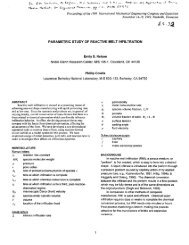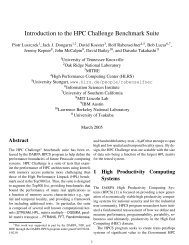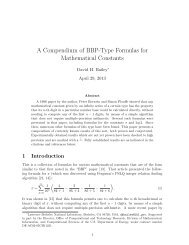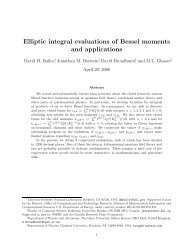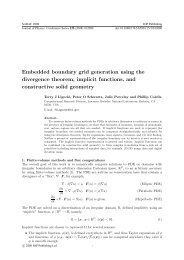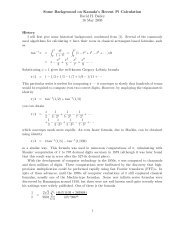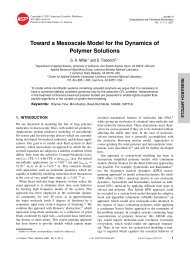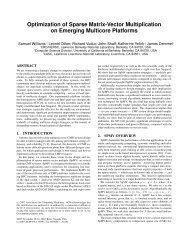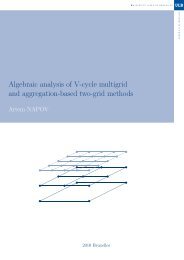High-Order, Finite-Volume Methods in Mapped Coordinates
High-Order, Finite-Volume Methods in Mapped Coordinates
High-Order, Finite-Volume Methods in Mapped Coordinates
Create successful ePaper yourself
Turn your PDF publications into a flip-book with our unique Google optimized e-Paper software.
where we adopt the po<strong>in</strong>twise notation q i±1 ≡ q(ξ 2 ed i± 1 ed). Thus, the faceaveragedflux is expressed <strong>in</strong> terms of po<strong>in</strong>twise values of v, u, and their2derivatives at the center of the face i ± 1 2 ed .The expansion of the <strong>in</strong>tegral (63) also gives po<strong>in</strong>twise values expressed <strong>in</strong>terms of face-averaged values. Specifically, for po<strong>in</strong>twise values of u and v,one can writev i±1 = 〈v〉 h22 ed i± 1 −ed2 24u i±1 = 〈u〉 h22 ed i± 1 −ed2 24∑d ′ ≠d∑d ′ ≠d∂ 2 v∂ξ 2 d ′ ∣ ∣∣∣∣ξ=ξi±12e d + O ( h 4) ,∂ 2 u∂ξ 2 d ′ ∣ ∣∣∣∣ξ=ξi±12e d + O ( h 4) .(65a)(65b)Thus, the average <strong>in</strong>terface flux is〈F〉 i±1 = 〈v〉 2 ed i± 1 ed〈u〉 h2i± 1 +ed2 2 12(∑ ∂vd ′ ≠d)∂u∂ξ d ′ ∂ξ d ′ξ=ξ i± 12e d + O ( h 4) , (66)written <strong>in</strong> terms of the face-averages 〈u〉 i±1 and 〈v〉 2 ed i± 1 and the po<strong>in</strong>twiseed2values of the gradients of u and v at the center of the face.In a f<strong>in</strong>ite-volume scheme, one works with cell-averaged values. Through theuse of primitive functions [16], one can construct face-averages directly <strong>in</strong>terms of cell averages; at fourth-order on a uniform grid, this yields thecentrally-differenced expression〈q〉 i+12 ed = 7 12 (¯q i + ¯q i+e d) − 1 12 (¯q i+2e d + ¯q i−e d) + O( h 4) . (67)To approximate the po<strong>in</strong>twise transverse gradients, we first note that an O(h 2 )approximation is sufficient. In the d ′ -th direction, a suitable centrally differencedapproximation is∂q= 1 (¯qi+e d∂ξ d ′ ∣ ξ=ξi±4h′ + ¯q i±e d +e − ¯q d′ i−e − ¯q ) ( )d′ i±e d −e + O h2. (68)d′12e dExpressions (67) and (68) provide the approximations necessary to evaluatethe face-averaged fluxes (66) to fourth-order given the cell averages of u andv on the computational grid.To obta<strong>in</strong> the average ū i from the average (uJ) i, we aga<strong>in</strong> appeal to Taylorseries expansion of the <strong>in</strong>tegrand to express the average of products as theproduct of averages:(uJ) i= ū i ¯Ji + h212 (∇ ξu · ∇ ξ J) i+ O ( h 4) . (69)20



